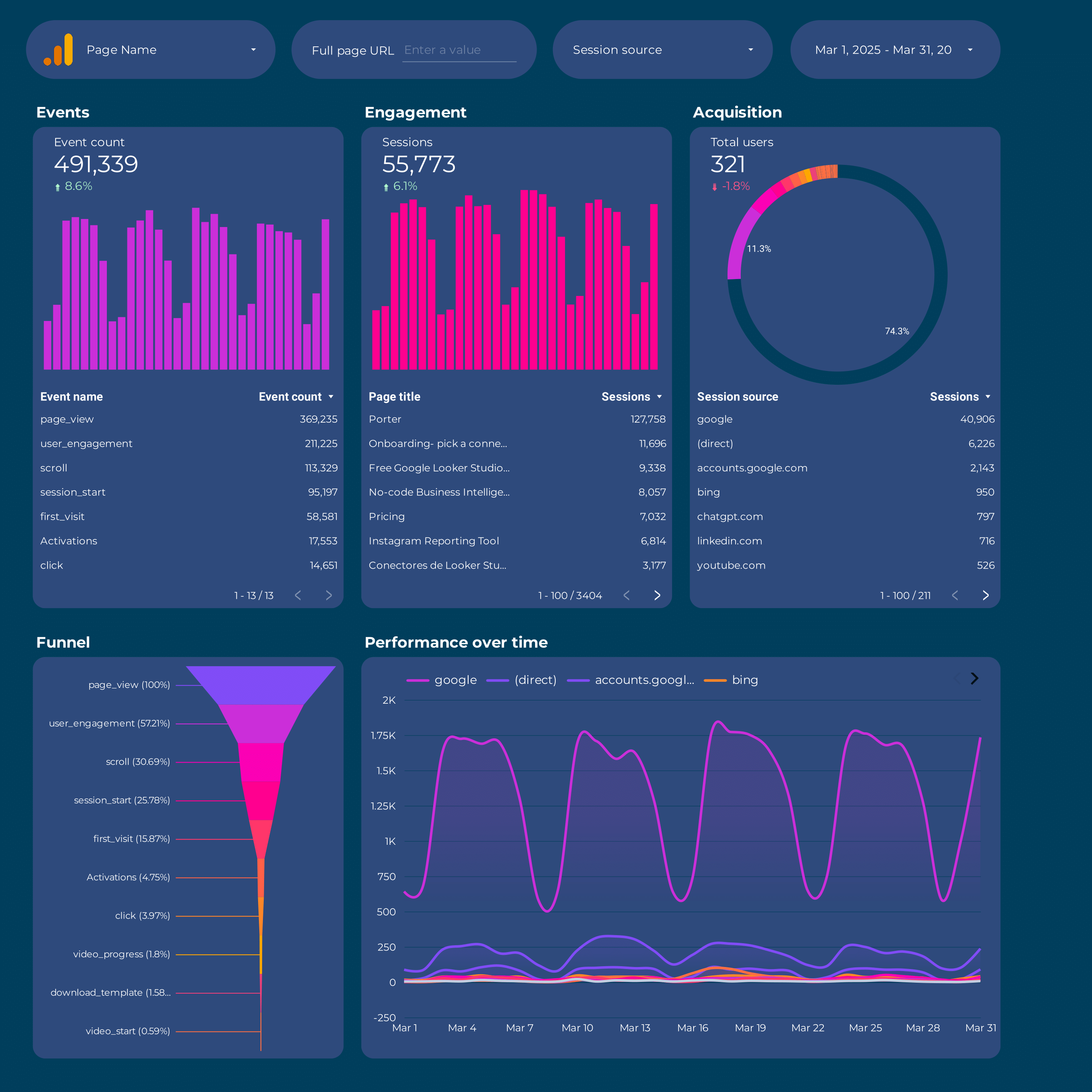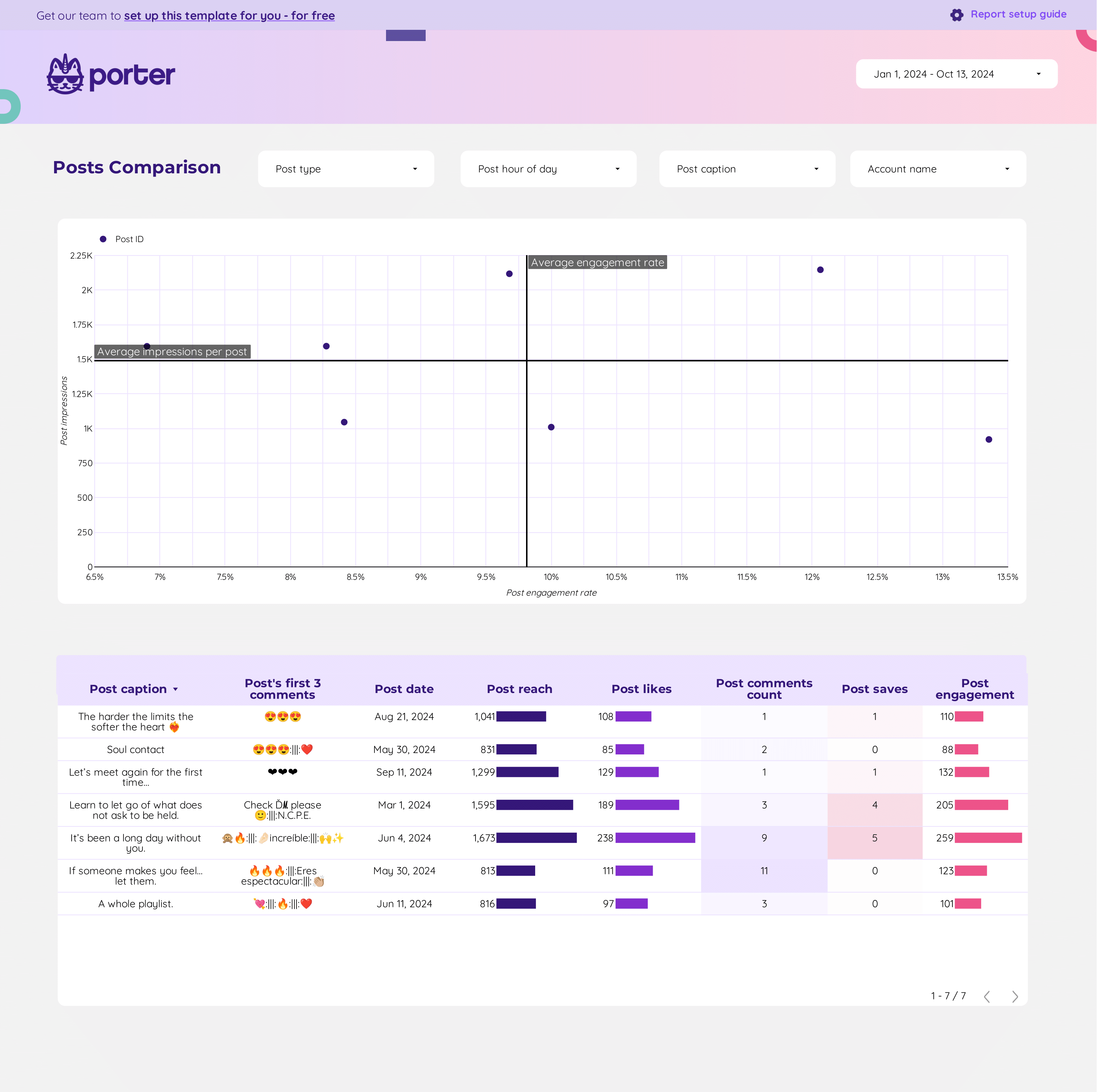
Google Analytics 4 Report template for Marketing teams and agencies
Optimize your e-commerce strategy with this Google Analytics 4 report template. Track conversion metrics, session duration, and bounce rate. Analyze impressions, CTR, and average position. Segment by campaign, age, gender, and device. View data by hour, day, or year. Perfect for marketing teams to enhance website performance and achieve objectives.

Google Analytics 4 acquisition Report template for Marketing teams and agencies
Analyze key metrics with this Google Analytics 4 acquisition report template. Track conversions, user engagement, and sessions. Segment by campaign, source, or time period. Designed for marketing teams to consolidate strategy and assess performance. Utilize Google Analytics 4 insights for actionable outcomes.

Google Analytics 4 Attribution Report template for Marketing teams and agencies
Analyze key metrics such as CTR, conversion rate, and cost per conversion with this Google Analytics 4 Attribution report template. Segment data by demographics, psychographics, and behavior over various timeframes. Designed for marketing teams to consolidate insights and refine strategies, utilizing Google Analytics 4 for a comprehensive view of audience engagement.

Google Analytics 4 Audience Report template for Marketing teams and agencies
Analyze key metrics with this Google Analytics 4 Audience report template. Track conversions, engagement, and user activity. Segment by campaign or audience across various timeframes. Designed for marketing teams to consolidate strategy and enhance performance insights.

Google Analytics 4 E-commerce Report template for Marketing teams and agencies
Track essential metrics like purchase and engagement rates with the Google Analytics 4 E-commerce report template. Analyze dimensions such as campaign source and user type. Measure performance across various time frames. Perfect for marketing teams to consolidate data and optimize strategies.

Inbound marketing Report template for Marketing teams and agencies
Optimize your strategy with this Inbound marketing report template. Track KPIs like conversion rates and social media engagement. Analyze data from CRM, E-commerce, Facebook Ads, Google Analytics 4, and LinkedIn Ads. Segment by demographics and timeframes. Ideal for B2B and e-commerce teams to measure performance and achieve marketing goals.

Lead generation Report template for Marketing teams and agencies
Optimize your strategy with the Lead generation report template. Track conversion rates, cost per conversion, and ROI. Analyze B2B, CRM, Email Marketing, and Facebook Ads data. Segment by audience, demographics, and behavior. Measure SQLs, sales cycle length, and CRM contact performance. Ideal for marketing teams seeking actionable insights.

Acquisition Report template for Marketing teams and agencies
This Acquisition report template helps marketing teams track key metrics like conversion rate, ROI, and CTR. Analyze dimensions such as target audience and campaign goals. Integrate data from Google Analytics 4, Copy, and PPC. Ideal for measuring performance and refining strategies to meet specific objectives.

Content marketing Report template for Marketing teams and agencies
Optimize your strategy with this Content marketing report template. Track key metrics like conversion rates, CTR, and website traffic. Analyze demographics, psychographics, and behavior using Google Analytics 4. Ideal for marketing teams to measure performance and achieve objectives across different timeframes.

Content performance Report template for Marketing teams and agencies
Optimize your social media strategy with the Content performance report template. Track conversion rates, engagement, and audience demographics using data from Google Analytics 4, Instagram Insights, and Facebook Insights. Analyze key metrics by campaign, duration, and time. Perfect for marketing teams to measure performance and achieve objectives efficiently.

Multi-channel Marketing performance Report template for Marketing teams and agencies
Optimize your strategy with the Multi-channel Marketing performance report template. Track CTR, ROI, and engagement metrics from SEO, Google Analytics 4, Facebook Ads, Instagram Insights, and more. Analyze channel performance and customer engagement by demographics and timeframes. Perfect for marketing teams to measure and improve performance across diverse platforms.

Paid media Report template for Marketing teams and agencies
Analyze key metrics like CTR, conversion rate, and CPA with this Paid media report template. Integrate data from Facebook Ads, TikTok Ads, Google Ads, and more. Segment by location, age, and interests. Ideal for PPC specialists to track performance and refine strategies across platforms using Google Analytics 4.

Demand generation Report template for Marketing teams and agencies
Optimize B2B demand generation with this report template. Track conversion rates, cost per conversion, and click-through rates. Analyze social media shares and impressions. Integrate data from CRM, E-commerce, Facebook Ads, Google Analytics 4, and LinkedIn Ads. Segment by demographics and time for strategic insights. Ideal for marketing teams focused on performance.

Paid media E-commerce Report template for Marketing teams and agencies
Track metrics like cost per conversion, ROAS, and CTR with the Paid media E-commerce report template. Analyze data from Google Analytics 4, Shopify, Google Ads, and Facebook Ads. Segment by audience, ad placement, and time. Perfect for marketing teams to measure performance and refine strategies.

Dropshipping Report template for Marketing teams and agencies
Optimize your marketing strategy with this Dropshipping report template. Measure conversion rates, average order value, and customer lifetime value. Segment by demographics, interests, and time. Consolidate data from E-commerce, Google Analytics 4, Shopify, Google Ads, and Facebook Ads. Perfect for tracking key metrics and enhancing performance in the competitive e-commerce landscape.

Shopify Store performance Report template for Marketing teams and agencies
Measure key metrics with the Store performance report template. Analyze total revenue, conversion rates, and traffic sources. Segment by audience, marketing channels, and campaign objectives. Consolidate data from E-commerce, Google Analytics 4, Shopify, Google Ads, Facebook Ads, and SEO. Perfect for marketing teams to track performance and optimize strategies.

DTC Report template for Marketing teams and agencies
Optimize your strategy with this DTC report template. Track revenue, conversion rates, and cost per acquisition. Blend data from E-commerce, Google Analytics 4, Shopify, Google Ads, and Facebook Ads. Segment by demographics, behavior, and time. Perfect for marketing teams to measure key metrics and enhance E-commerce performance.

Website Report template for Marketing teams and agencies
Analyze key metrics with this Website report template. Track conversion rates, average order value, and customer lifetime value. Measure audience demographics, interests, and behavior using Google Analytics 4. Segment data by time periods. Perfect for marketing teams to consolidate insights and refine strategies.

E-commerce Report template for Marketing teams and agencies
Optimize your strategy with this E-commerce report template. Track metrics like conversion rate, average order value, and CPA. Analyze dimensions by audience, channel, and time. Integrate data from E-commerce, Paid Media, and SEO. Ideal for marketing teams to measure performance and achieve goals effectively.

